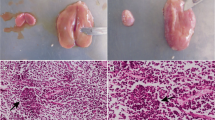Summary
Clinical, pathological and epizootiological studies were carried out in an experimental flock of 39 sheep that was exposed to natural infection ofTheileria hirci in an enzootic area. A morbidity rate of 100 per cent and a mortality rate of 89.74 per cent were observed in this flock which had been transferred from another enzootic region. NoTheileria hirci infection was observed, during the same period, in the control sheep which were sprayed regularly. The high morbidity and mortality rate in the flock might have been due to the existence of antigenically different strains in different localities. Almost all the ticks collected from the sheep during the course of the study wereHyalomma spp.
Résumé
Des études cliniques, pathologiques et épizootologiques ont été entreprises dans un troupeau d'expérience de 39 moutons exposés à l'infection naturelle parTheileria hirci dans une zone d'enzootie. Un taux de morbidité de 100 pour 100 et un taux de mortalité de 89,74 pour 100 ont été observés dans ce troupeau qui provenait d'une région d'enzootie. Aucune infection àTheileria hirci n'a été observée pendant la même période chez 10 moutons témoins qui étaient douchés régulièrement. La haute incidence des taux de morbidité et de mortalité du troupeau d'expérience est probablement du à l'existence de diverses souches antigéniquement différentes d'une localité à l'autre. Presque toutes les tiques récoltées sur les moutons pendant la durée de l'étude appartenaient à l'espéceHyalomma spp.
Sumario
Se llevaron a cabo estudios clínicos, epizootilógicos y patológicos en un hato experimental de 39 ovinos el cual estuvo expuesto a la infeccion natural en un area enzootica. Se observó un porcentaje de morbilidad del 100 por ciento y un porcentaje de mortalidad del 89.74 por ciento en este hato, el cual habia sido transferido de un area enzoótica. No se observó ninguna infección conT. hirci durante el mismo periodo en el grupo control (diez ovinos) los cuales fueron pulverizados en forma regular. La alta incidencia en morbilidad y mortalidad en el hato fue postulada ser debida a la existencia de cepas antigenicamente distintas en localidades diferentes. Casi la totalidad de garrapatas colectadas de los ovinos durante el curso del estudio fueronHyalomma spp.
Similar content being viewed by others
References
Baumann, R. (1939). Die kleinasiatische Schaftheiloriose.Berliner und Munchener Tierarztliche Wochenschrift. Jahrg 1939. pp. 469–474. Quoted by Neitz (1957).
Dschunkowsky, E. &Urodschevich, V. (1924). Theileriosis in goats, sheep, and cattle with a description ofTheileria hirci (nov. sp.) from Serbia.Parasitology, Vol. 16. pp. 107–110.
Hoogstraal, H. &Kaiser, M. N. (1958). The tick (Ixodoidea) of Iraq: Keys, Hosts and Distribution.Journal of Iraqi Medical Profession. Vol. 6 (2–3), pp. 1–22.
Kardassis, I. &Margaratis, I. (1964). Outbreak ofTheileria ovis infection in goats in Greece.Bulletin de la Societe Veterinaire Hellinique. Vol. 15, pp. 174–179.
Khayyat, S. M. &Gilder, A. A. (1947). Ovine piroplasmoses in Iraq.Transactions of the Royal Society of Tropical Medicine and Hygiene. Vol. 41, pp. 119–126.
Lestoquard, F. (1926). Piroplasmoses du mouton et de la chevre.Archives de l'Institut Pasteur d'Algerie. Vol. 4, p. 222.
Levine, N. D. (1961).Protozoan parasites of Domestic Animals and Man. pp. 313–314. Burgess Publishing Company, Minneapolis 15, Minnesota.
Littlewood, W. (1915).Annual Report for the year 1914. Veterinary Services, Ministry of Agriculture, Government Press, Cairo. Quoted by Neitz (1957).
Mason, F. E. (1915).Annual Report for the year 1914. Veterinary Services, Ministry of Agriculture, vet. path. Rept., Government Press, Cairo. Quoted by Neitz (1957).
Neitz, W. O. (1957). Theileriosis, Gonderioses and Cytauxezoonoses: a Review.Ondersteppoort Journal of Veterinary Research. Vol. 27. pp. 275–430.
Robson, J. &Robb, J. N. (1967). Ticks (Ixodoidea) of Domestic Animals in Iraq.Journal of Medical Entomology. Vol. 4, pp. 289–293.
Sergent, E., Donatien, A., Parrot, L. &Lestoquard, F. (1945).Etude Sur Les Piroplasmoses Bovines Institut Patseur D'Algerie.Algar, pp. 96–100.
Yakimoff, W. L. (1929). Endoglobulare Parasiten der Schafe im Nordkaukasus.Archiv fur Protistenkunde Vol. 65. pp. 151–164. Quoted by Neitz (1957).
Author information
Authors and Affiliations
Additional information
Near East Animal Health Institute, Veterinary Laboratories, Abu Ghraib, Baghdad, Iraq: A Project of the Ministry of Agriculture, Iraq, supported by the United Nations Development Programme, with the Food and Agriculture Organisation as the executing agency.
Rights and permissions
About this article
Cite this article
Hooshmand-Rad, P., Hawa, N.J. Malignant theileriosis of sheep and goats. Trop Anim Health Prod 5, 97–102 (1973). https://doi.org/10.1007/BF02236144
Accepted:
Issue Date:
DOI: https://doi.org/10.1007/BF02236144




